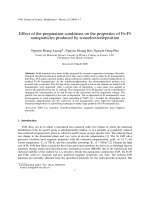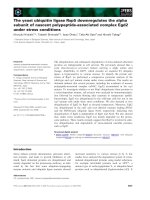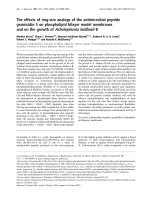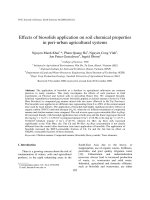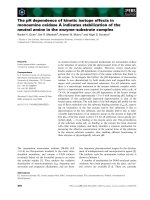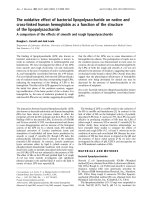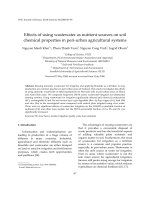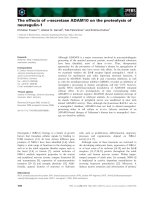Báo cáo " Effects of the conditions of the microemulsion preparation on the properties of Fe3O4 nanoparticles " pot
Bạn đang xem bản rút gọn của tài liệu. Xem và tải ngay bản đầy đủ của tài liệu tại đây (543.64 KB, 7 trang )
VNU Journal of Science, Natural Sciences and Technology 24 (2008) 9-15
9
Effects of the conditions of the microemulsion preparation on
the properties of Fe
3
O
4
nanoparticles
Nguyen Thai Ha
1
, Nguyen Hoang Hai
1,
*
Nguyen Hoang Luong
1
, Nguyen Chau
1
, Huynh Dang Chinh
2
1
Center for Materials Science, Faculty of Physics, College of Science, VNU
334 Nguyen Trai, Hanoi, Vietnam
2
Faculty of Chemical Technology, Hanoi University of Technology
1 Dai Co Viet, Hanoi, Vietnam
Received 12 March 2008
Abstract. Fe
3
O
4
nanoparticles have been prepared by the microemulsion technique with water as
the aqueous phase, n-hexane as the oil phase and Span 80 as the surfactant. The reaction occurred
under air, N
2
or high temperature and high pressure atmosphere. Particle size can be controlled by
the concentration of the reactants dissolved in water, the ratio of water/surfactant and the
atmospheric conditions. The particle size is of 6 - 20 nm. They are superparamagnetic with the
saturation magnetization of 50 emu/g. Functionalization of the particle surface has been carried out
by using a single layer of oleic acid for hydrophilic surface and double layer of oleic acid and
sodium dodecyl sulfate for hydrophilic surface to disperse them in non-aqueous and aqueous
solvents, respectively. Changing the conditions of the preparation affected to the properties of the
product. This technique showed advantages such as simple, small size particles, monodisperse
over the coprecipitation methods.
Keywords: Magnetite nanoparticles, microemulsion, superparamagnetic, Fe
3
O
4
.
1. Introduction
*
Magnetic fluids are of interest of many
researchers due to their potential applications in
physics and biology [1,2]. Magnetic fluids
consist of magnetic nanoparticles, a surfactant
and a carrier liquid. The magnetic properties of
magnetic fluids are determined by magnetic
nanoparticles (NPs). The surfactant helps
_______
*
Corresponding author. Tel.: 84-4-5582216.
E-mail:
nanoparticles to disperse in the carrier liquid.
The carrier liquid can be polarized or non-
polarized depending on applications. As a
result, it is necessary to choose a proper
surfactant for nanoparticles disperse in the
carrier liquid. Magnetic particles are normally
required to have a high saturation magnetization
M
s
, biocompatibility, low-cost and stability
under the working environment. Magnetite
Fe
3
O
4
are widely used to make magnetic fluid
because that material can fulfill above
requirements. For biological applications, two
N.T. Ha et al. / VNU Journal of Science, Natural Sciences and Technology 24 (2008) 9-15
10
nano effects have been taken into account,
which are high surface area and
superparamagnetic property. Super-
paramagnetic NPs have no coercive field and
no remanent magnetization but they do have
high magnetization under a magnetic field. This
fact is important for biological applications
when it is desired to have high magnetization
when a magnetic field is applied and to have no
magnetization when the magnetic field is off.
While magnetite particles are required to have
the diameter less than about 20 nm in order to
be superparamagnetic at room temperature, the
surface effect is stronger when particle size is
smaller. In addition, particle size distribution is
very important for ensuring all particles have
the same magnetic properties. The simplest way
to make magnetite fluids is coprecipitation Fe
3+
and Fe
2+
ions by OH
-
at room temperature [3].
However, this method has a problem to obtain
particles with diameter of less than 10 nm and
with small size distribution.
Microemulsion (inverse micelle) is suitable
way for obtaining the uniform and size
controllable nanoparticles [4]. A microemulsion
may be defined as a thermodynamically stable
dispersion of two immiscible liquids consisting
of small droplets of one or both liquids
stabilized by an interfacial film of surface
active molecules (surfactant, stabilizer). In
water-in-oil microemulsions, the aqueous
(water) phase is dispersed as microdroplets
surrounded by a monolayer of surfactant
molecules in the continuous non-aqueous
(hydrocarbon) phase. If a soluble metal salt is
incorporated in the aqueous phase of the
microemulsion, it will reside within the aqueous
droplets surrounded by oil. These microdroplets
continuously collide, coalesce and break again.
If two identical microemulsions are produced
with a reactant P dissolved in the aqueous cores
of one microemulsion and a reactant Q in the
other microemulsion, upon mixing, they will
form precipitate PQ, which will be contained
entirely within the aqueous cores of the
microemulsions. The growth of these particles
in microemulsions is suggested to involve inter-
droplet exchange and nuclei aggregation.
2. Experiment
The synthesis process occurred via the
mixing of two microemulsion systems with
identical compositions but different aqueous
phase types – one containing metal ions
(reactant A), the other, a precipitating agent
(reactant B). The first one consisted of an
aqueous solution of iron chloride salts
(FeCl
2
.6H
2
O and FeCl
3
.6H
2
O) dispersed in the
Sorbian monooleate (Span 80)/n-hexane. The
second system comprised a precipitating agent
NH
4
OH dispersed in the Span 80/n-hexane. The
two microemulsions were mixed together under
continuous stirring (typically 2 hr) to obtain
nanoparticles. We obtained a water-in-oil
reverse microemulsion system, in which Span
80 as surfactant to stabilize the emulsion state,
n-Hexane as the continuous oil phase (o), and
the aqueous phase (w) containing c = 0.2 - 0.4
M Fe
2+
(the concentration of Fe
3+
was adjusted
to keep the ratio of Fe
3+
/Fe
2+
to be 2:1 - reactant
A), was used for synthesis of magnetite NPs.
Particle size could be adjusted by changing
concentration c of the reactant in the aqueous
phase, changing the volume ratio of water and
surfactant (w/s = 20 - 100), and the reaction
atmosphere (300 K/1.0 at and 450 K/1.5 at).
There were three types of samples: (A) mixing
in air, (B) after mixing in air, the system was
N.T. Ha et al. / VNU Journal of Science, Natural Sciences and Technology 24 (2008) 9-15
11
submitted to an atmosphere with temperature of
180°C and pressure of 1.5 at for a time of 8 hr,
and (C) mixing in N
2
. High temperature and
pressure in case B fostered the reaction to form
nanoparticles. In type B, we combined the
microemulsion and the hydrothermal technique.
When reaction completed, magnetic decantation
was applied to remove NPs from the excess
solution. Then oleic acid (OA) as a surfactant
was mixed to coat NPs. Using magnetic
decantation and washing by n-Hexane four
times, OA-coated NPs dispersed in n-Hexane
was made. The fact that Span 80 could not be
used to coat NPs was due to the molecule of
this surfactant could not create a chemisorption
with magnetite surface while OA could [5]. For
dispersing in water, Sodium dodecyl sulfate
(SDS) was used as a second layer of surfactant.
The hydrophobic part of SDS tended to the
hydrophobic part of OA, which created a
hydrophilic surface on nanoparticles (SDS/OA-
coated nanoparticle).
Structure analysis of the dried powder of
non-coated NPs was conducted by using a
D5005 X-ray diffractometer with Cu Kα
radiation. Magnetic properties were measured
by a DMS 880 vibrating sample magnetometer.
Morphology of NPs was examined by a JEOL
5410 LV scanning electron microscope. Weight
loss (Thermal Gravity Analysis) as a function
of temperature (heating rate of 10°C/min) was
studied by a DSC SDT 2960 TA Instruments.
3. Results and discussion
The mechanism of formation of particles
was understood as a short single burst of
nucleation occurred when the concentration of
constituent species reached critical
supersaturation. Then, the nuclei so obtained
were allowed to grow uniformly by diffusion of
solutes from the solution or/and aggregation of
other nuclei to their surface until the final size
was attained. In conventional coprecipitation,
size (d) can be controlled by concentration of
reactants [5], pH and ionic strength [6]. Size of
12 - 100 nm could be made by this technique.
Fig. 2. Typical SEM image of magnetite
nanoparticles (type C).
20 30 40 50 60 70
0
10
20
30
40
50
Intensity (degree)
2 θ
θθ
θ (degree)
Fig. 1. XRD patterns of magnetite powder with
concentration of Fe
2+
of 0.2 M in the aqueous phase
.
The solid squares present the theoretical reflections
of Fe
3
O
4
(pdf # 790418).
N.T. Ha et al. / VNU Journal of Science, Natural Sciences and Technology 24 (2008) 9-15
12
Smaller particle size is difficult to obtain.
Microemulsion can produce small particles with
diameter can be less than 10 nm, which
coprecipitation technique cannot do [7]. In
microemulsion, amount of reactant is limited in
a volume of the microdroplet, which can be
controlled by water/surfactant ratio and
atmospheric conditions.
XRD patterns of the dried non-coated NPs
of type C sample with different concentration
(0.2 and 0.4 M) of reactant (w/s = 20) were
shown in Fig. 1. All reflections are of magnetite
Fe
3
O
4
. These indicated that the particles have
the invert spinel crystalline structure as in the
bulk phase. The width of peaks of the sample
with higher concentration was broader than that
of the peaks of sample with lower
concentration. That means high concentration
produced large particles. By controlling
concentration, we could control the particle
size. It suggested a way to obtain desired
particles. Particle diameter can be determined
by Cherrer formula [8]:
θ
λ
sin
9.0
B
d =
(1)
where
λ
is the wave length of the X-ray,
θ
is the
reflection angle, and B is the full width at half
maximum of the peak. The particle diameter
obtained from that for all samples was in the
range from 7 nm to 22 nm.
A typical scanning electron microscope
(SEM) image of magnetite sample (type C, w/s
= 20) coated by OA was presented in Fig. 2.
Particle size was less than 10 nm which is in
agreement with a value from XRD results.
Some features of this image showed particle
size can be 5-6 nm. Similar images were
obtained for other samples.
Magnetic properties of sample of type A
prepared under ambient conditions were non-
ferromagnetic at room temperature, which can
be understood by the fact that the reaction could
not complete under these conditions. Whereas,
magnetic properties of samples of type B were
ferromagnetic with the saturation magnetization
M
s
of 50 emu/g and the coercive field H
c
of 50
Oe at room temperature for sample with c = 0.1
M. M
s
and H
c
reduced when the concentration
0 100 200 300 400 500 600 700
80
85
90
95
100
% Weight loss
T (C)
Fig. 4. Weight loss as a function of temperature of
OA-coated NPs of type C sample with c = 0.2 M.
-10000 -5000 0 5000 10000
-40
-20
0
20
40
M (emu/g)
H (Oe)
c = 0.4
c = 0.3
c = 0.24
c = 0.2
Fig. 3. Magnetization curves of of type C samples
with different concentrations of the reactant.
N.T. Ha et al. / VNU Journal of Science, Natural Sciences and Technology 24 (2008) 9-15
13
of reactant lowered and reached 20 emu/g and 5
Oe, respectively, for sample with c = 0.025 M.
The critical diameter d
c
at which ferromagnetic
property becomes superparamagnetic was
determined from the equivalent condition of
magnetic energy and thermal energy:
kTKV 25=
(2)
where K is anisotropy constant of material that
makes NPs (magnetite), V is the volume of
particle. V is proportional to d
c
3
, k is the
Boltzman constant and T is the absolute
temperature. For magnetite, critical diameter is
about 20 nm. The ferromagnetism in type B
samples may come from the particles with the
size d larger than the critical dimension. Large
particles were formed when the microemulsion
systems was under high temperature and high
pressure, which made the microdroplets become
bigger because the interfacial energy increased
with the temperature and pressure. In some
bioapplications such as hyperthermia,
ferromagnetic behavior is required. So this type
of sample can be applied for such applications.
Samples of type C showed superparamagnetic
behavior. The magnetization curve of these
samples with concentration of 0.2 M - 0.4 M
was given in Fig. 3. Highest M
s
of 50 emu/g
was reached for sample with c = 0.4 M. The
value of M
s
reduced to 35, 30, and 25 emu/g
when the concentration was 0.3, 0.24, and 0.20
M, respectively. This can be ascribed to the
smaller particle size in the sample with low
concentration in which, amount of reactant
limited in a droplet of microemulsion was
smaller than that in the droplet of high
concentration. As a result, smaller particles
were formed in the low concentration samples.
Small particle possesses larger surface layer
whose magnetization was normally lower than
that of the bulk material. With type C samples,
value of M
s
was also dependent on the ratio w/s
in a way which was similar to other types of
samples. The saturation magnetization reduced
with w/s. With w/s smaller than 60, M
s
of about
50 emu/g does not change significantly.
However, at higher w/s, the value of M
s
reduces
faster and lowers to 35 emu/g at w/s = 100. The
explanation for that is the same as the argument
above. Therefore, the optimum ratio is chosen
to be 20.
Among three ways for the preparation of
magnetic nanoparticles, microemulsion in N
2
atmosphere was the best way to produce
superparamagnetic particles. The particle size
can be controlled by adjusting the concentration
of reactants, volume ratio of water/surfactant.
Magnetic nanoparticles tend to form
clusters to reduce surface energy. To disperse
NPs in a solvent, we need a stabilizer. There are
two types of solvents: polarized (such as water)
and non-polarized (such as n-hexane). Each
type of solvent requires suitable stabilizer
(known as another name “surfactant”).
Polarized and non-polarized solvent only allow
hydrophilic and hydrophobic particles to be
dispersed, respectively. Therefore, the particles
must be coated by a surfactant which makes
them hydrophilic or hydrophobic. That
surfactant must have a strong contact with the
particles. The contact that comes from
hydrophobic affinity in such the case of Span
80 was much weaker than that came from
chemisorption in such the case of OA. With
OA, the hydrophilic carboxyl group attached to
particle surface and left the hydrocarbon chain
outward [5]. So that, OA-coated NPs have
hydrophobic surface which makes them be
dispersed in non-polarized hexane. Weight loss
N.T. Ha et al. / VNU Journal of Science, Natural Sciences and Technology 24 (2008) 9-15
14
of a typical OA-coated NPs of type C sample
with c = 0.2 M was presented in Fig. 4. In the
temperature range lower than 200°C, the loss
was about 2% which can be explained by the
evaporation of remained water. There was a 17 %
weight loss appeared in the range 200°C -
250°C, which resulted from the evaporation of
OA coating NPs. From the weight loss of OA-
coated NPs (17%) and supposing that there was
a single layer of OA molecules around particles
and the area of a OA molecule took place on the
particle surface was about 0.3 nm
2
[9], we can
estimate particle size of NPs was about 8 nm.
The result is reasonably in agreement with SEM
observation. To make NPs hydrophilic, we used
double layer of surfactant by coating another
layer of SDS on the OA-coated NPs. The
hydrocarbon chain of SDS tended inward to the
hydrocarbon chain of OA and gave the particle
a hydrophilic surface. These SDS/OA-coated
NPs can be dispersed in polarized liquid such as
water. In many bioapplications, NPs are
required to be dispersed in water, this way
functionalizing of NPs is a potential for that.
Especially, the double layer coated NPs have a
hydrophobic space between the two layers. This
space can be used as a carrier to load
hydrophobic drug and with an assistance of an
external magnetic field, the double layer coated
NPs can be applied for magnetic drug delivery
[10].
4. Conclusion
By adjusting concentration of reactant,
water/surfactant ratio, reaction atmosphere in
microemulsion method, we can produce
magnetic nanoparticles with particle size of less
than 10 nm. Microemulsion technique under N
2
atmosphere is a versatile way to produce
magnetic nanoparticles. The particles can be
dispersed in polarized or non-polarized solvents
by coating a single layer or double layer of
relevant surfactant around NPs. The
nanoparticles are suitable for biological
applications.
Acknowledgement
This work is financially supported by the
Vietnam National Fundamental Research
Program for Natural Sciences, project 406506.
References
[1] R.E. Rosensweig, Ferrohydrodynamics,
Cambridge: Cambridge University Press, 1985.
[2] D.L. Leslie-Pelecky, V. Labhasetwar, R.H.
Kraus, Jr., Nanobiomagnetics, in Advanced
Magnetic Nanostructures, D.J. Sellmyer and R.
S. Skomski, Eds. New York: Kluwer, 2005.
[3] P. Berger, N.B. Adelman, K.J. Beckman, D.J.
Campbell, A.B. Ellis, G.C. Lisensky,
Preparation and Properties of an Aqueous
Ferrofluid, J. Chem. Edu. 76 (1999) 943.
[4] I. Capek, Preparation of metal nanoparticles in
water-in-oil (w/o) microemulsions, Adv. Colloid
Int. Sci. 110 (2004) 49.
[5] C. V. Thach, N. H. Hai, N. T. Ha, H. D. Chinh,
N. Chau, Size controlled magnetite nanoparticles
and their drug loading ability, J. Korean Phys.
Soc. in press.
[6] P. Tartaj, M.d.P. Morales, S. Veintemillas-
Verdaguer, T. Gonzalez-Carreno, C.J. Serna,
The preparation of magnetic nanoparticles for
applications in biomedicine, J. Phys. D: Appl.
Phys. 36 (2003) R182.
[7] M.P. Pileni, Reverse micelles as microreactors,
J. Phys. Chem. 97 (1993) 6961.
[8] B.D. Cullity, Elements of X-Rray Diffraction,
Addison-Wesley Publishing, Reading, MA
(1978).
N.T. Ha et al. / VNU Journal of Science, Natural Sciences and Technology 24 (2008) 9-15
15
[9] L.P.R. Rios, Superpara- and paramagnetic
polymer colloids by miniemulsion processes,
PhD thesis, Posdam University (2004).
[10] T.K. Jain, M.A. Morales, S.K. Sahoo, D.L.
Leslie-Pelecky, V. Labhasetwar, Iron Oxide
Nanoparticles for Sustained Delivery of
Anticancer Agents, Mol. Pharm. 2 (2005) 194.
Ảnh hưởng của các ñiều kiện chế tạo trong phương pháp nhũ
tương lên tính chất của hạt nano Fe
3
O
4
Nguyễn Thái Hà
1
, Nguyễn Hoàng Hải
1
,
Nguyễn Hoàng Lương
1
, Nguyễn Châu
1
, Huỳnh ðăng Chính
2
1
Trung tâm Khoa học Vật liệu, Khoa Vật lý, Trường ðại học Khoa học Tự nhiên,
ðại học Quốc gia Hà Nội, 334 Nguyễn Trãi, Hà Nội, Việt Nam
2
Khoa Công nghệ Hóa học, Trường ðại học Bách khoa Hà Nội
1 ðại Cồ Việt, Hà Nội, Việt Nam
Hạt nano Fe
3
O
4
ñã ñược chế tạo bằng phương pháp nhũ tương sử dụng nước, hexane và chất hoạt
hóa bề mặt Span 80. Phản ứng tạo hạt nano xảy ra trong môi trường không khí (với áp suất và nhiệt ñộ
khí quyển và áp suất và nhiệt ñộ cao) và khí nitơ. Kích thước hạt nano từ 6 ñến 20 nm. Hạt có tính siêu
thuận từ với từ ñộ bão hòa ñạt ñến 50 emu/g. Việc chức năng hóa bề mặt kỵ nước ñược thực hiện nhờ
olecic acid, chức năng hóa bề mặt ưa nước bằng lớp hoạt hóa bề mặt kép gồm oleic acid và sodium
dodecyl sulfate. Thay ñổi ñiều kiện chế tạo ảnh hưởng nhiều ñến tính chất hạt nano. Hạt nano tạo bằng
phương pháp này có những tính chất ưu việt so với phương pháp ñồng kết tủa là hạt nhỏ, ñộ ñồng nhất
cao.
